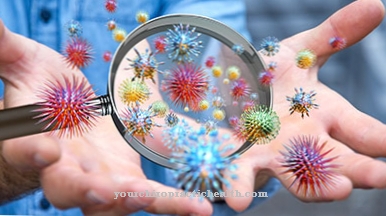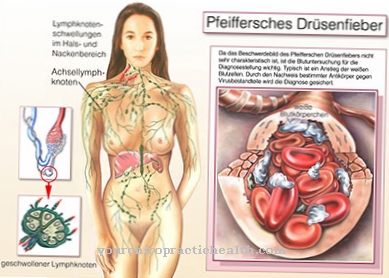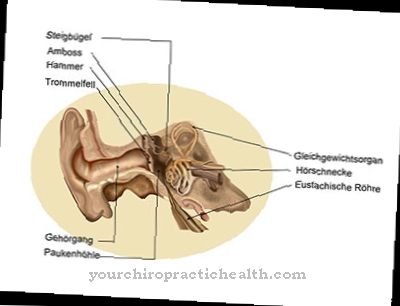The post-thrombotic syndrome is the result of a phlebothrombosis of the deep arm or leg veins and corresponds to a backflow congestion with defects in the venous valves. The cause of PTS is the body's attempt to heal itself, trying to make the veins permeable again after a thrombosis. Treatment for PTS focuses on compression and movement.
What is Post Thrombotic Syndrome?

© vencav - stock.adobe.com
Thromboses are local intravascular blood clots in the circulatory system. Usually they are preceded by changes in the vessel walls, abnormalities in blood flow or changes in the composition of the blood. Phlebothrombosis is a special form of thrombosis that causes a thrombotic occlusion of deep veins and is associated with the risk of pulmonary embolism.
The deep veins include the deep leg and arm veins. The post-thrombotic syndrome (PTS) summarizes the pathological consequences of permanent damage in the deep leg and arm vein system. After an endogenous inflammatory process, the occlusion often results in damage to the venous valves. Chronic backflow congestion is the result.
The arms are less affected by PTS than the legs. A post-thrombotic syndrome after phlebothrombosis can develop into venous insufficiency. Four stages of PTS are known: Stage I with a tendency to edema, Stage II with induration, Stage III with sclerotic tissue changes and Stage IV with extensive ulcerations.
causes
The cause of PTS is phlebothrombosis of the deep arm or leg veins. The closure is usually of a permanent nature and lasts for several days. The body tries to break up the clot in the vein by starting an inflammatory process in the vein wall. The clot rarely actually completely dissolves.
The immunologically inflammatory reaction corresponds to a self-healing attempt, which is supposed to make the vital veins permeable again. When inflamed, the venous valves in the affected area are often attacked or destroyed.
The venous valves form an essential part of the reflux mechanism. If they are destroyed, the affected veins are no longer fully functional. It is from this context that the post-thrombotic syndrome develops. Almost half of all patients with thrombosis of the deep arm or leg veins suffer from the phenomenon.
Symptoms, ailments & signs
Patients with post-thrombotic syndrome suffer from a complex of different symptoms. The main symptom is backflow congestion in the affected vein. On the basis of this phenomenon, abnormal sensations occur in the respective extremities, such as a feeling of heaviness or pain in tension.
As a result of the back pressure, edema can form over time. In addition, there are often restricted mobility of the affected extremity. Symptoms also appear on the patient's skin as the syndrome progresses. The most common skin symptoms are trophic disorders associated with thinning of the skin epithelium. In addition, pigment changes can occur.
In many cases, wound healing in the affected area is impaired. Wound healing disorders can occur after the smallest injuries, which are often associated with chronic ulceration. Lower leg ulcers, swelling and pain are accompanying symptoms of PTS. The severity of PTS depends on the severity of the causal thrombosis and personal factors such as previous illnesses, occupation or gender.
Diagnosis & course of disease
The diagnosis of post-thrombotic syndrome is made by means of duplex sonography or by means of X-ray examinations with administration of contrast medium. The vein occlusions including the bypass circuits are usually clearly visible on the imaging. In individual cases, vein thromboses are not recognized for several years.
In these cases, a post-thrombotic syndrome can develop unnoticed and unpredictably before the patient has even found out about a suffered thrombosis. For patients with post-thrombotic syndrome, the prognosis depends on the severity and time of diagnosis of the initial thrombosis. The earlier the thrombosis and the associated syndrome are recognized, the better the prognosis.
Complications
With this syndrome, those affected suffer from various ailments. As a rule, severe abnormal sensations or sensitivity disorders occur in the extremities. This may make the patient's everyday life more difficult, resulting in significant restrictions. In some cases, those affected depend on the help of other people in their life because of the syndrome.
Restrictions of movement are also not uncommon, so that the patient may need a walking aid. Most of those affected also suffer from impaired wound healing. Even minor injuries can lead to profuse bleeding or wounds that do not heal. The joints are also often swollen and painful. The syndrome has a very negative effect on the patient's quality of life and can also lead to psychological complaints or depression.
Treatment of this syndrome is usually done with the help of medication and compression stockings. There are no complications. Various therapies are also necessary in order to permanently alleviate the symptoms. The syndrome usually does not reduce or otherwise affect life expectancy.
When should you go to the doctor?
A doctor is needed in the event of sudden or intense circulatory disorders. If they stop or increase in intensity, they are to be understood as a warning from the organism. There is a need for action, since acute health-threatening conditions can develop in severe cases.
Restrictions on movement, unsteady gait, dizziness or internal weakness should be presented to a doctor. If there are changes in the complexion, abnormal sensations on the skin or pain, the person concerned needs help. Numbness in the extremities, a tingling sensation on the skin and impaired perception are considered unusual. They should be presented to a doctor as soon as they continue unabated for several days or weeks.
Swelling, the formation of ulcers or edema should be clarified by a doctor. Consult a doctor if you are sensitive to pressure, have changes in the layers of the skin or if you feel inner heaviness. Irregularities in the natural healing of wounds, an increased body temperature or a general feeling of illness should be examined and treated.
It is characteristic of the disease that even small wounds show a problematic development. If the person concerned notices a decrease in physical performance, if fatigue develops quickly, if a general malaise develops or if there is a low level of resilience, medical help should be sought.
Treatment & Therapy
For patients with post-thrombotic syndrome, the basic principle of using compression is the focus of treatment. Compressions can be applied externally by applying compression bandages with or initiated with medical compression stockings. The muscle pump must be activated during compression therapy.
For this reason, the patient must regularly and actively move the affected extremity, for example by cycling or walking. The exercise units must not overload the affected extremity. Extreme endurance sports should therefore be avoided. In the resting position, the affected extremity is ideally elevated to provide additional relief for the damaged venous system.
In individual cases, patients are given diuretic drugs. An anticoagulant with inhibitors such as coumarins is more often used to prevent repeated thrombosis. The basic principle for the time of therapy is to walk and lie instead of standing and sitting. The recent past has shown that consistent compression therapy alone cannot counteract the disease sufficiently.
Movement is therefore an inescapable step in therapy. In severe cases of PTS, damaged veins may need to be replaced. For this purpose, either donor veins are transplanted or vein parts are produced using modern technology such as the 3D printer and used for the patient.
prevention
The post-thrombotic syndrome can be prevented to the extent that thrombosis of the deep venous systems can be prevented. As long as there is no thrombosis, there can be no post-thrombotic syndrome. In the context of thrombosis, preventive measures include, for example, a balanced diet with sufficient fluid intake and plenty of exercise. Abstinence from nicotine is also considered a preventive measure. In addition, long periods of sitting or standing are not recommended.
== aftercare Almost every second patient develops a post-thrombotic syndrome after a deep vein thrombosis. The symptoms can then become so severe that it can lead to massive impairments in everyday life and the ability to work. Complete healing is hardly possible, so aftercare aims to improve the blood circulation and reduce existing pain.
Consistent and regular follow-up treatment with follow-up examinations is therefore essential. The basic pillars of aftercare are consistent compression therapy with compression stockings (usually for life) and the maintenance and improvement of the mobility of the affected patients. This is done, among other things, through adapted physiotherapy with the improvement and maintenance of muscular activity in the affected areas.
This ensures better muscle pumping function. This in turn reduces the symptoms of congestion. In particular, the arthrogenic congestion syndrome (stiffening of the ankle) should be prevented. Likewise effective and necessary is the prescription of lymph drainage to prevent feelings of tension and congestion symptoms.
Furthermore, careful skin care should be ensured. The skin is more susceptible to injuries and to infectious pathogens, which in the worst case can lead to complications such as sepsis. Therefore, regular medical check-ups should be carried out, as mentioned, to counteract the development of venous ulcers.
You can do that yourself
In the case of post-thrombotic syndrome (PTS), the patient should always be active. Because especially when the disease is not yet too advanced, a lot of exercise helps the body to counteract the side effects of the syndrome. Regardless of whether the arm or leg veins are affected, sports and types of exercise such as hiking, cycling, walking, etc. are recommended. However, overloading should be avoided.
Overall, the following rule applies to the patient: "Better to run and lie than stand and sit." When lying down, however, you should also ensure that the affected extremities are consistently elevated. At the same time, the affected areas should be compressed. This is best done with support stockings and / or compression bandages. According to the doctor's instructions, they usually have to be worn constantly. Since this is often perceived as unpleasant by the patient, this therapeutic measure requires a high level of compliance. A compression stocking or hose not only supports the venous system, but also protects the skin from injuries.
If post-thrombotic syndrome (PTS) is already advanced, patients often suffer from water retention and joint inflammation. The inflammation can be carefully cooled by the patient himself. In the event of water retention, you should see a doctor, who may prescribe water-driving agents (diuretics).




.jpg)






















